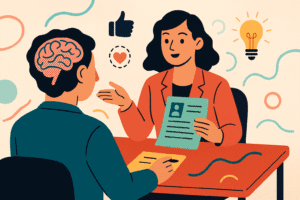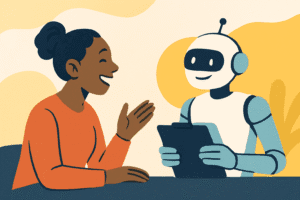Wanna know a secret? Interviews aren’t just about your answers. They’re about psychology, perception, and… yes, vibes.
To pull off a great interview, you need a mix of targeted prep, practiced answers, and a bit of “go with the flow” confidence. Take what you’ve learned from the rest of your job hunt and your top-notch resume and cover letter, and turn it into a performance that will leave them wanting more.

Step 1: Tame the Nerves
Interviews are high-stress for even the most seasoned interviewer. You have to be vulnerable, likable, confident—all while being evaluated by a stranger.
If you’re not mentally prepped, your “fight or flight” instinct might kick in. That’s when you ramble, freeze, or overshare. It’s not the end of the world, but a little preparation goes a long way.
Start with research. Know the company, the role, and (if you can) the interviewer. Create a doc or notebook with quick-reference notes and your top questions. Use a consistent format to stay organized. Don’t write out full answers—opt for bolded keywords or short lists to jog your memory. Pro tip: Feeling extra nervous? Look up the interviewer on LinkedIn, YouTube, or in news articles. Getting a feel for their tone or style makes them feel more familiar, and less intimidating.
Then, get in the zone. Your hype-up routine is personal. Maybe it’s music (we’re partial to Body by Megan Thee Stallion), a hot shower, caffeine, sugar, or a quick walk. Whatever gets you mentally sharp. Have water nearby (it’s great for a dry throat and for buying a few seconds to think.)
Finally: don’t rush. Give yourself buffer time. If you’re going in person, plan for traffic and find a quiet place to center yourself before you go in. Just don’t check in more than 5-10 minutes early.
Step 2: Nail the First Impression
It’s not exactly fair, but it’s human nature to form opinions fast. Your first few minutes matter more than most people admit.
Dress for your audience. Forget “always wear a suit.” Instead, aim to look slightly sharper than your interviewer. If they’re in a t-shirt, you go business casual. If it’s a bank job, level up. Think about the full package: piercings, tattoos, hair, makeup. You don’t need to change who you are, just be aware that people are (consciously or not) forming opinions based on these cues.
Perfect your intro. Also known as the elevator pitch. It’s not your resume—it’s your story. Who are you? What are your strengths? Why this job? Keep it brief, but personal. Include a quick detail to make it memorable:
I’ve actually been a customer and had a great experience with your support team, and that’s part of what drew me to the role.
Bonus: Zoom-specific tips. Good lighting. Clean background. Quiet space. Look at the camera once in a while. (And yes, lock the door. Even from cats.)
Step 3: Know Your Strengths
You won’t know every question in advance, but you can bet on the classics:
- What do you know about our company?
- Where do you see yourself in 5 years? (or similar variations on your aspirations)
- What are your strengths and weaknesses?
- Why are you looking for a new job?
- What is one of your proudest accomplishments?
Then there’s the behavioral set: How did you handle a tough deadline? A difficult customer? A disagreement at work? Those are tough to handle on-the-spot. Prep 3-4 flexible stories that you can adapt to different questions. Start here:
- A time you made a mistake and grew from it
- A change you implemented
- A cross-functional project you helped complete
- A moment you showed leadership
Structure matters, and it will help you from meandering. The STAR method is a favorite for a reason:
- Situation – What was going on?
- Task – What were you responsible for?
- Action – What did you actually do?
- Result – What was the outcome?
Pro tip: It’s easy to do, but don’t skip the result. It’s the part they remember.
Step 4: Know Thy Enemy
It may feel like the interviewer has all the power, but they’re human, too. Some aren’t even trained to interview well. That’s where psychology can help.
Match their energy.
Chatty interviewer? Be conversational. No-nonsense question-firer? Keep it crisp and focused.
Ask questions.
Even if they’re driving, you can still steer a little. Thoughtful questions show interest and subtly shift the dynamic.
Biases to use (or avoid)
- Timing bias: If you get a choice, you might have a more cheerful interviewer by avoiding Monday mornings, lunch time, and Friday afternoons. And if you’re choosing between being first or middle of the pack, choose middle and you’ll avoid tricky comparisons and effects of recency bias that come from being first.
- Negativity bias: We remember bad stuff more easily than good. If you flub an answer, ask to reframe it. Or if asked about a skill you lack, pivot to a related one you’re learning.
- Similarity bias: People like people who remind them of themselves. Shared interests? School? A sincere compliment? Use it. Even saying their name once or twice can help build connection.
- Confirmation bias: Interviewers will sometimes ask questions to confirm their hunch about you. If they keep digging into one area—good or bad—lean into it and make your case.
Step 5: Flip the Script
You’re not just being interviewed. You’re interviewing them, too. Most interviews end with: “Any questions for us?”
Always have questions ready. Tailor them to the person you’re talking to. A recruiter can speak to culture and benefits. A hiring manager can talk team dynamics or goals.
Ask what you actually want to know (hours, location, structure) but also deeper stuff:
- How does your team handle feedback?
- What are the company’s top goals this year?
- What does onboarding look like?
Skip the trick question. We know some people advise to end with:
Is there any reason you wouldn’t move me forward?
…but we don’t love it. It puts the interviewer in an awkward spot and triggers the very biases you’re trying to avoid. Instead, end on a strong note:
This role sounds like a great fit. I’m really excited about the company because ... , and I’d love the chance to move forward.
After all that: don’t forget to be you. Over-rehearsed answers and perfect delivery can make you sound like an interview robot (and not the charming kind). What stands out most? Your stories. Your energy. That one moment you made them smile.

Remind them of one of these unique stories by sending a quick thank-you note (2 to 24 hours later) that doesn’t sound like ChatGPT wrote it.
A great interview isn’t just about being qualified. It’s about showing up calm, clear, and human.
Prep your mindset. Bring your best. Make a connection. You’ve got this.
